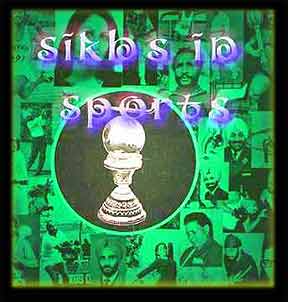


The 'Sikh'- as a Sportsman
Sikhs, throughout the ages, have been distinct warfare people. Not only Sikhs, but the people of Punjab were so much under the threat of invaders from the Khyber Pass, that their lives always remained in tension that kept them on their toes. This attitude, sometimes helped them to vanquish the invaders or sometimes left them on the losing end.
The circumstances of Punjab were in turmoil during Guru Nanak's time,when Babar, the Mogul, invaded India and with his most 'organized' army he swept aside the disorganized Punjabi resistance. This disorganization was the main cause of defeat for the Punjabis, as they did not lack valour, strength or bravery. They were natural athletes - running and walking for miles and miles, climbing mountain ranges, swimming in the five rivers, fencing, archery and other fighting skills were there, but not in an organized and disciplined manner.
Guru Nanak preached the existence of One God and tried to reform the masses to get out of useless and baseless rituals that were the downfall of the society. His preaching for the attainment of Godliness, was mostly through 'naam simran' and 'good deeds' - the concept of which was carried on through to the fifth Guru, Guru Arjan. Guru Arjan was martyred by the Mogul Emperor Jehangir and this atrocity by the Mughals laid the foundation of the 'Martial' Sikh, which was later on to go on to become the unassailable Khalsa.
Guru Hargobind, the sixth Guru, who wore the two swords of 'Miri and Piri' became the first "Commander-in-Chief" of the Sikh Panth and paved the way to the Khalsa Brotherhood. During His times, the discipline and regular training camps came into existence which filled the Sikhs with 'martial spirit', and the wrestling competitions tested the strengths of the down-trodden Sikhs. Guru Hargobind, thus was the initiator of the 'Sikh Sports and Martial Arts'.
The Sikhs carried on getting stronger mentally and physically, until the ninth Guru, Guru Teg Bahadur - son of Guru Hargobind, was martyred by the Mogul Emperor Aurangzeb. This was another arrow fired at the 'Sikh Heart' that erupted in the form of the "Khalsa".
The tenth Guru, the sage and "Dusht Daman" from Hemkunt, whose spiritual powers knew no bounds as He was sent by the Almighty Himself, who had declared 'Gobind' as His son:-
Akwl purK bwc]cOpeI] mYN Apnw suq qoih invwjw ] pMQ pRcur krby khu swjw ] jwih qhW qY Drmu clwie ] kbuiD krn qy lok htwie ]29] ( bic`qR nwtk )
With God's blessings, Guru Gobind Singh created the 'purest of the pure'- "The KHALSA" "pMQ clY qb jgq mYN jb qum krhu shwie"
The foundation laid by Guru Hargobind, was now starting to take shape, and the 'Sikh Panth' transformed into the "Khalsa Panth", whose valor and audacity was acknowledged from Kashmir to Kanya Kumari.
Guru Gobind Singh revolutionized the occasion of 'Holi' to 'Hola Mohalla' and after the Khalsa was created in AD 1699, this festival at Anandpur Sahib was subsequently uplifted with the inclusion of martial arts as one of its salient features. Guru Ji divided his army into two groups and made them fight mock battles - hence strengthening their military techniques and fighting abilities. 'Dangals' (Wrestling) were held and lots of other sports such as horse riding, running, athletics etc., were the main features of the 'Hola Mohalla'.
Then came the time of the Sikh 'Misals' (time before the Sikh Raj) , when again the Khalsa was threatened by invaders like Nader Shah and Ahamed Shah Abdali. These invaders, though successful in their raids, could not help admiring the Khalsa 'bands', who gave them the most resistance and recovered most of the loot which the invaders had gathered to be taken to Iran or Afghanistan.
Maharaja Ranjeet Singh re-grouped the 'misals' and brought them under one 'Khalsa' flag - thus the Sikh Rule was established in the Punjab. The Maharaja was a keen sportsman cum warrior - as it was during his period that the "Basant Panchmi" occasion was celebrated for ten days, and during these days, competitions in athletics, martial arts, horse riding, spear throwing, archery, sword fighting etc., were featured and the youth of Punjab was invited to participate in this magnificent 'mela'. It was here in 1805 AD that this 'mela' brought into limelight the greatest of Sikh Generals - Hari Singh Nalwa, whose all-round athletic proficiency, his sword fighting and archery, and horse riding so much impressed the Maharaja, that he took him in his arms and made him his personal bodyguard.
The bravery and valor of the Khalsa has been known since then in various tumultuous times, such as the fight for independence when the Sikhs were the most martyred nation than any other nation of India.The Namdhari and the Gaddar movements are a witness to this.The Namdhari Shaheeds Hira Singh and Lehna Singh's names are on the forefront of Sikh defence against the British tyranny and the sixty six namdhari shaheeds who were blown by cannons leave an indelible mark on the 'Shaheedi' history of India. Shaheed-e-Azam Bhagat Singh and Shaheed Udham Singh are those Sikhs whose bravery and self respect remains unchallenged.
After Independence, it was the Sikh dominated hockey team that brought all the available tournament honours to its country. Now-a-days the Namdhari Hockey Team, whose discipline and 'Sikhi Rehat' has made it the most respected and talented hockey teams of India. Not a single tournament cup has escaped their mighty clutches. Milkha Singh was the first Indian Sikh athlete to gain any recognition in the Olympics. Great stalwarts like Dara Singh, Randhawa excelled in the fields of wrestling. Bishan Singh Bedi - an excellent bowler in the field of Cricket, and many more Sikhs- not forgetting the Kenya Sikh Union , whose Kenya Hockey Captain Avtar Singh Sohal was a record breaking Captain during four consecutive Olympics. On the rally roads, the name of Joginder Singh stands out as the first Sikh and Indian to win the tortuous East African Rally for four times - leaving the worlds best drivers biting the dust.
Sri Satguru Partap Singh Ji was a very keen sportsman. He encouraged His Sikhs to participate in all sports. He personally used to wrestle in 'akharas' and teach His followers the art of wrestling. His name in the horse racing circles remains a legend as no known race evaded his well groomed horses - ably ridden by Namdhari jockeys. The Namdhari tug-of-war team, a dynamic force in the Punjab, remains unchallenged till now.
Sri Satguru Jagjit Singh Ji, again, encourages all namdhari sporting activities, especially the hockey team. He himself is a great player of badminton and His fitness at the age of eighty is a rare phenomenon. The Nation feels proud as the Sikhs represent many different countries as their Nationals, in many different sports.
In U.K., there is not a city or county that does not boast a local Sikh hockey team. The Satguru Partap Singh annual hockey tournament is a highlight of hockey tournaments in U.K. The name "SINGH" is a lion - whose 'ROAR' is now heard in the 'WORLD OF SPORTS'.